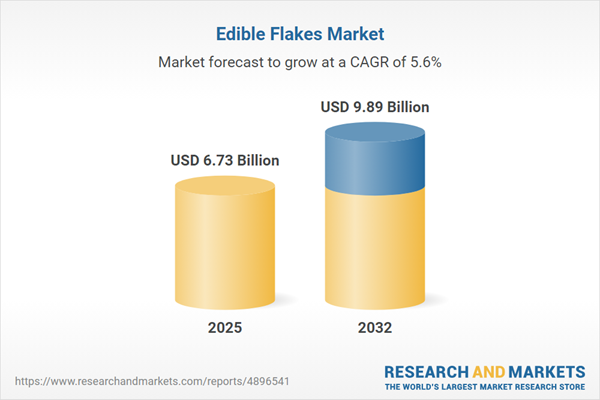Speak directly to the analyst to clarify any post sales queries you may have.
Senior decision-makers in the edible flakes market are navigating a complex period defined by shifting consumer demands, heightened regulatory expectations, and fast-paced digital transformation. The ability to adapt strategy, supply chains, and product offerings is now central to securing competitive advantage.
Market Snapshot: Edible Flakes Market Growth & Forecast
The edible flakes market is currently valued at USD 6.38 billion in 2024, expected to grow to USD 6.73 billion in 2025, and projected to reach USD 9.89 billion by 2032, reflecting a CAGR of 5.64%. Growth is propelled by rising consumer preference for nutritious, convenient foods, alongside increased adoption of digital technologies within supply and customer management frameworks. Companies leveraging research, digitization, and compliance capabilities remain well-placed to capture value in both established and emerging regions as the industry expands.
Scope & Segmentation of the Edible Flakes Market
- Product Types: Includes corn flakes, a range of oat varieties, various rice flakes, wheat flakes, and multigrain blends, supporting market presence across retail and foodservice channels with diversified nutrition options.
- Distribution Channels: Supermarkets, hypermarkets, convenience outlets, specialty stores, and e-commerce platforms each contribute to expanded wholesale and direct-to-consumer reach, facilitating broader brand adaptation.
- End Uses: Applications now encompass breakfast cereals, snack products, bakery inclusions, low-sugar varieties, fortified solutions, and animal feed, offering suppliers multiple pathways to diversify product portfolios and access adjacent sectors.
- Flavors: A portfolio spanning chocolate, berry, tropical, savory, and plain variations enables targeted formulations aligned with evolving consumer preferences and region-specific demand.
- Ingredient Types: The market is experiencing growth in vitamin-fortified, mineral-enriched, clean-label, natural, and allergen-friendly formulations, with a rising need for adherence to varied global labeling and safety standards.
- Key Regions: The Americas, Europe, Asia-Pacific, and Middle East & Africa each require locally informed compliance approaches due to distinct regulatory landscapes and consumer behaviors, supporting tailored go-to-market strategies for each area.
- Leading Companies: Major enterprises, including Kellogg Company, General Mills, Nestlé S.A., Post Holdings, PepsiCo, Mondelēz International, Conagra Brands, The Kraft Heinz Company, Grupo Bimbo, and Associated British Foods, invest in digital supply chain technology and continuous product innovation to meet evolving market needs.
Edible Flakes Market: Technological and Regional Drivers
Adoption of data-driven tools and intelligent supply chain solutions is transforming how manufacturers react to changing market conditions and compliance requirements. Real-time analytics support precise demand prediction, while digital engagement channels amplify direct customer insights. As companies evolve product lines in response to distinct regional compliance and consumer expectations, collaboration with local partners helps overcome operational barriers and extend distribution reach across diverse regulatory environments.
Key Takeaways for Senior Decision-Makers
- Investing in health-centric product development, such as allergen-sensitive and protein-enhanced variants, enhances brand positioning and trust among business buyers and consumers.
- Utilizing real-time data analytics and supply chain automation improves responsiveness to regulatory updates and shifts in customer requirements, strengthening operational agility.
- Applying advanced digital marketing enables focused audience segmentation, supporting sustainable brand visibility and market share in highly competitive segments.
- Prioritizing transparent sourcing and adopting sustainable packaging builds stronger ties with institutional buyers and supports overall compliance initiatives.
- Localizing sourcing and distribution capability minimizes exposure to global supply chain risks, ensuring business continuity and consistent client service.
- Expanding flavor offerings and customizing formulations for regional markets encourages loyalty and extends influence in both established and emerging geographies.
Tariff Impact: Navigating 2025 U.S. Trade Measures
Imminent U.S. tariffs targeting imported grains and packaging components are increasing cost pressures throughout the edible flakes sector. Manufacturers are responding by emphasizing domestic procurement, forming new supplier alliances, and scaling collective purchasing to limit cost escalation. While larger organizations leverage stronger negotiating positions, smaller firms build partnerships and reinforce local sourcing to maintain profitability. These approaches help maintain operational stability and ensure a level of competitiveness in the face of regulatory change.
Methodology & Data Sources
This report synthesizes direct insights from industry executives and exhaustive secondary investigations in the food ingredient sector. Peer review and comprehensive validation underpin the reliability of guidance for senior decision-makers, supporting informed strategic planning.
Why This Report Matters
- Enables leaders to refine operational strategies and compliance processes in an evolving edible flakes market affected by consumer, technological, and regulatory shifts.
- Supports development of robust risk management approaches, ensuring organizations adapt efficiently to supply and compliance disruptions as the industry transforms.
- Guides innovation and operational efficiency improvements, strengthening cost containment and business agility amid ongoing digitalization.
Conclusion
This concise analysis equips senior executives with actionable intelligence to strengthen strategy, reinforce supply chain resilience, and enhance positioning as the edible flakes market advances.
Additional Product Information:
- Purchase of this report includes 1 year online access with quarterly updates.
- This report can be updated on request. Please contact our Customer Experience team using the Ask a Question widget on our website.
Table of Contents
3. Executive Summary
4. Market Overview
7. Cumulative Impact of Artificial Intelligence 2025
Companies Mentioned
The companies profiled in this Edible Flakes market report include:- Kellogg Company
- General Mills, Inc.
- Nestlé S.A.
- Post Holdings, Inc.
- PepsiCo, Inc.
- Mondelēz International, Inc.
- Conagra Brands, Inc.
- The Kraft Heinz Company
- Grupo Bimbo, S.A.B. de C.V.
- Associated British Foods plc
Table Information
| Report Attribute | Details |
|---|---|
| No. of Pages | 183 |
| Published | October 2025 |
| Forecast Period | 2025 - 2032 |
| Estimated Market Value ( USD | $ 6.73 Billion |
| Forecasted Market Value ( USD | $ 9.89 Billion |
| Compound Annual Growth Rate | 5.6% |
| Regions Covered | Global |
| No. of Companies Mentioned | 11 |









